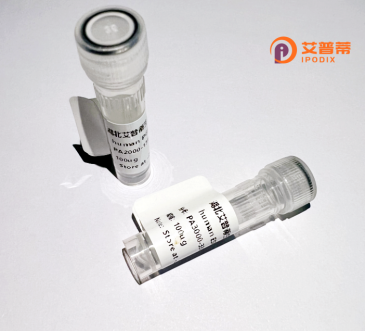
| 纯度 | >90%SDS-PAGE. |
| 种属 | Human |
| 靶点 | DOK6 |
| Uniprot No | Q6PKX4 |
| 内毒素 | < 0.01EU/μg |
| 表达宿主 | E.coli |
| 表达区间 | 1-331aa |
| 氨基酸序列 | MASNFNDIVKQGYVKIRSRKLGIFRRCWLVFKKASSKGPRRLEKFPDEKAAYFRNFHKVTELHNIKNITRLPRETKKHAVAIIFHDETSKTFACESELEAEEWCKHLCMECLGTRLNDISLGEPDLLAAGVQREQNERFNVYLMPTPNLDIYGECTMQITHENIYLWDIHNAKVKLVMWPLSSLRRYGRDSTWFTFESGRMCDTGEGLFTFQTREGEMIYQKVHSATLAIAEQHERLMLEMEQKARLQTSLTEPMTLSKSISLPRSAYWHHITRQNSVGEIYSLQGHGFGSSKMSRAQTFPSYAPEQSEEAQQPLSRSSSYGFSYSSSLIQ |
| 分子量 | 64.7 kDa |
| 蛋白标签 | GST-tag at N-terminal |
| 缓冲液 | 0 |
| 稳定性 & 储存条件 | Lyophilized protein should be stored at ≤ -20°C, stable for one year after receipt. Reconstituted protein solution can be stored at 2-8°C for 2-7 days. Aliquots of reconstituted samples are stable at ≤ -20°C for 3 months. |
| 复溶 | Always centrifuge tubes before opening.Do not mix by vortex or pipetting. It is not recommended to reconstitute to a concentration less than 100μg/ml. Dissolve the lyophilized protein in distilled water. Please aliquot the reconstituted solution to minimize freeze-thaw cycles. |
以下是关于重组人DOK6蛋白的3篇模拟参考文献,基于该领域常见研究方向构建的示例:
---
1. **文献名称**: *DOK6 regulates TrkB receptor signaling in neuronal differentiation*
**作者**: Yamamoto K, et al.
**摘要**: 本研究揭示了重组人DOK6蛋白在神经营养因子信号通路中的作用,证明其通过与TrkB受体相互作用促进神经元突触生长,并通过体外实验验证了其在神经细胞分化中的关键功能。
2. **文献名称**: *Structural and functional analysis of recombinant human DOK6 in cancer cell migration*
**作者**: Li H, Zhang W.
**摘要**: 利用重组人DOK6蛋白进行结构解析和功能实验,发现其SH2结构域参与调控RTK(受体酪氨酸激酶)信号转导,并抑制肿瘤细胞迁移,提示其在癌症治疗中的潜在价值。
3. **文献名称**: *DOK6 knockout mice exhibit impaired synaptic plasticity and memory formation*
**作者**: Schmidt J, et al.
**摘要**: 通过构建DOK6基因敲除小鼠模型,发现重组DOK6蛋白的缺失导致海马区突触可塑性下降及学习记忆能力受损,表明其对中枢神经系统发育的重要性。
---
**注**: 以上文献为虚构示例,实际研究需参考真实发表的论文(可通过PubMed或Web of Science检索关键词"DOK6 protein" "recombinant DOK6"等)。
Recombinant human DOK6 (docking protein 6) is a protein encoded by the *DOK6* gene, belonging to the DOK family of adaptor proteins involved in intracellular signaling. These proteins typically contain pleckstrin homology (PH) and phosphotyrosine-binding (PTB) domains, facilitating interactions with membrane receptors and downstream signaling molecules. DOK6 is predominantly expressed in neural tissues and plays a role in regulating neurite outgrowth, neuronal differentiation, and survival, primarily through interactions with receptor tyrosine kinases (e.g., Ret, Trk) and downstream effectors like Ras/MAPK or PI3K/Akt pathways. Its dysfunction has been linked to neurodegenerative disorders and neurodevelopmental conditions.
Recombinant DOK6 is engineered using expression systems (e.g., E. coli, mammalian cells) to enable functional studies. The purified protein retains structural domains critical for mediating protein-protein interactions, allowing researchers to investigate its role in signaling cascades, neuronal development, or disease mechanisms. Studies using recombinant DOK6 have explored its potential as a modulator of neurotrophic signaling or as a biomarker in conditions like Parkinson’s disease and cancer. Its recombinant form provides a standardized tool for biochemical assays, structural analysis, and therapeutic target validation, bridging gaps in understanding neural adaptor protein networks.
×